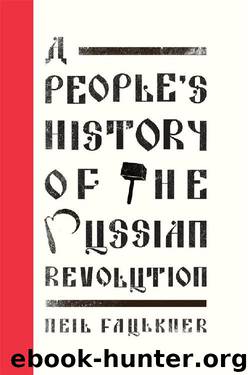A People's History of the Russian Revolution (Left Book Club) by Neil Faulkner

Author:Neil Faulkner [Faulkner, Neil]
Language: eng
Format: epub, azw3
ISBN: 9781786800213
Publisher: Pluto Press
Published: 2017-01-20T08:00:00+00:00
CHAPTER SIX
Dual Power
The July Days. Demonstrators scatter as right-wing gunmen open fire from upper-floor windows.
The First Provisional Government
It had been one of the greatest popular revolts in history. The battle had been waged entirely through the mass action of the Narod, the common people of Russia. The bourgeoisie – the financial, commercial, and industrial capitalists – had played no part whatsoever. The middle class – the civil servants, the upper professionals, the intelligentsia – had watched events unfold from their balconies. The socialist leaders had either said nothing at all, or they had said nothing that made any difference. There was no leadership of any kind ‘from above’. The workers and peasant-soldiers of Petrograd had made the revolution all by themselves, as it were ‘from below’, and the rest of plebeian Russia had followed their lead.
Yet power now passed not to the workers, but to the liberal-bourgeois politicians of the Cadet Party, organised as a ‘Provisional Committee’ (soon to become ‘Provisional Government’) of the Tsarist Duma – a fake parliament of ‘lords and lackeys’ elected on a restricted franchise heavily weighted in favour of the rich. The new government was the work of Pavel Milyukov, a history professor and head of the Constitutional Democrats (or Cadets), a liberal party of the middle class and intelligentsia favouring constitutional monarchy. The Cadets had formed a ‘Progressive Bloc’ with the Octobrists, a pro-Tsarist party of the nobility and the bourgeoisie whose leading figure was a rich Moscow finance-capitalist called Alexander Guchkov.
Behind the scenes, as the action unfolded on the streets, Milyukov had spent five sleepless days trying to construct a Progressive Bloc government – a new conservative regime to restore order, defend property, and continue the war. His first effort was an abortive attempt to replace Tsar Nicholas (who was soon under house arrest) with his brother Mikhail – that is, to swap one autocrat for another. Mikhail, fearing for his own safety, refused to play his assigned role. It was then that Milyukov sat down and wrote out a list of ministers. It was a cabinet of Duma conservatives dominated by the Cadet Party. It included one token socialist: Alexander Kerensky.1 This, then, was a government of landlords, industrialists, and right-wing professors. It seemed that the mountains in labour had given birth to a mouse. Trotsky called it ‘the paradox of the February Revolution’. What had happened?
Another power had in fact come into existence: the Soviet of Workers’ Deputies (soon to become the Soviet of Workers’ and Soldiers’ Deputies). The 1905 Revolution had taught this lesson: that the common people in action can best be organised by a pyramid of participatory democratic assemblies, the lowest bodies comprising mass meetings of everyone in a factory, barracks, battleship, or whatever, these electing delegates to the higher bodies.
But whereas the 1905 Soviet (the word simply means ‘council’ or ‘assembly’) had originated as a strike committee – in other words, had emerged ‘from below’ out of the class struggle itself – the 1917 Soviet was an initiative of the radical intelligentsia.
Download
A People's History of the Russian Revolution (Left Book Club) by Neil Faulkner.azw3
This site does not store any files on its server. We only index and link to content provided by other sites. Please contact the content providers to delete copyright contents if any and email us, we'll remove relevant links or contents immediately.
| Anthropology | Archaeology |
| Philosophy | Politics & Government |
| Social Sciences | Sociology |
| Women's Studies |
The Secret History by Donna Tartt(18188)
The Social Justice Warrior Handbook by Lisa De Pasquale(11957)
Thirteen Reasons Why by Jay Asher(8461)
This Is How You Lose Her by Junot Diaz(6451)
Weapons of Math Destruction by Cathy O'Neil(5841)
Zero to One by Peter Thiel(5498)
Beartown by Fredrik Backman(5369)
The Myth of the Strong Leader by Archie Brown(5243)
The Fire Next Time by James Baldwin(5024)
How Democracies Die by Steven Levitsky & Daniel Ziblatt(4966)
Promise Me, Dad by Joe Biden(4911)
Stone's Rules by Roger Stone(4866)
100 Deadly Skills by Clint Emerson(4695)
A Higher Loyalty: Truth, Lies, and Leadership by James Comey(4555)
Rise and Kill First by Ronen Bergman(4548)
Secrecy World by Jake Bernstein(4393)
The David Icke Guide to the Global Conspiracy (and how to end it) by David Icke(4386)
The Farm by Tom Rob Smith(4329)
The Doomsday Machine by Daniel Ellsberg(4250)
